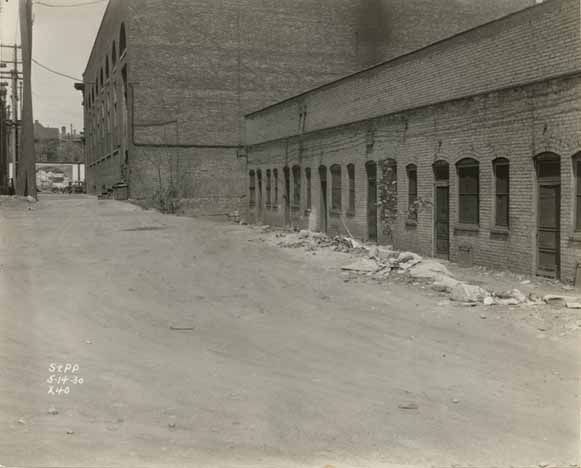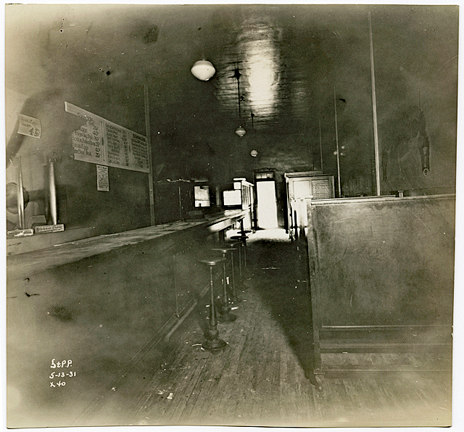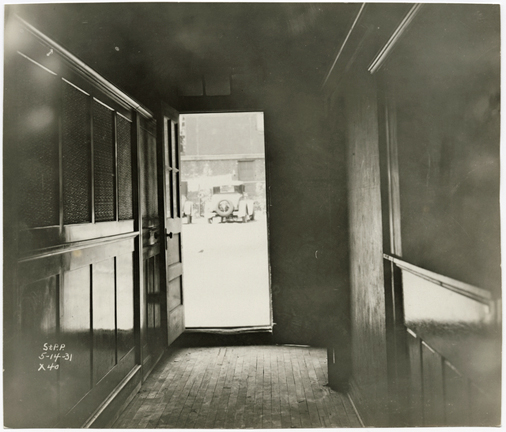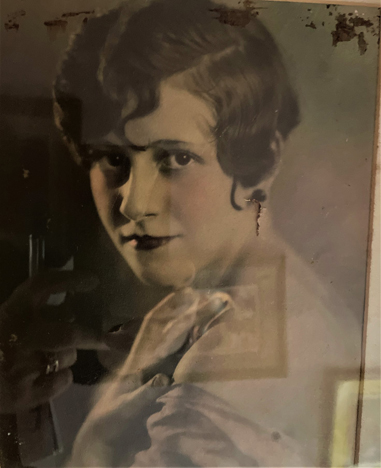Green Lantern I
545 1/2 Wabasha
St. Paul
This is the story of the original Green Lantern of the 1920s. For the Green Lantern that existed in the 1970s, click here.
The Green Lantern! A mysterious place where nefarious goings-on… went on. Dave Matheney of the Minneapolis Tribune gave its address as 545 1/2 Wabasha in an article dated June 13, 1991.
And now, photos have emerged that give us a peek into this infamous speakeasy known for gangsters and violence and everything bad about Prohibition and the Dirty Thirties.
From the St. Paul Pioneer Press: Nick Woltman, April 13, 2019
Photos recently discovered appear to show notorious St. Paul gangster hangout Green Lantern
The Green Lantern, which closed in 1934, was the center of the city’s underworld and a magnet for criminals like Kid Cann, John Dillinger and Doc Barker. But no photos of the bar’s interior were known to exist, leaving historians and true crime fans to speculate about what the Wabasha Street watering hole was like.
And it might have stayed that way if a local hood hadn’t been shot to death outside its back door in 1931.
A handful of crime-scene photos recently discovered in the files of the St. Paul Police Historical Society appear to depict the Green Lantern during its heyday. Its dirty floors and cramped booths undermine the glamorous myth of the city’s gangster era, painting a grittier picture of life on the wrong side of the law.
Jeff Neuberger, the amateur historian who found the photos, believes they were shot for use as evidence in the murder trial of John Quinn, who was convicted of killing Frank Ventress in the alley behind the Green Lantern.
Neuberger, who has worked as a custodian for the St. Paul Police Department since 2000, has scoured police and property records to support his conclusion.
“It would be a huge deal to have photographic evidence of the Green Lantern,” said Paul Maccabee, whose 1995 book John Dillinger Slept Here was the first comprehensive chronicle of St. Paul’s Prohibition-era crime wave. “It would be a cause for celebration among crime historians.”
The Green Lantern was the linchpin of the city’s infamous “O’Connor System,” named for then-Police Chief John J. O’Connor, who invited criminals from across the country to lie low in St. Paul as long as they behaved while they were in town.
America’s most wanted would check in at the Green Lantern when they arrived, and the bar’s proprietor would pass along their information to the city’s corrupt police force.
When Maccabee was researching his book, he searched high and low for photos of the legendary speakeasy, which was demolished decades ago to make way for an apartment complex.
“I was never able to find photos,” he said. “It was a hangout for killers and crooks, so that’s not so surprising.”
SHEDDING LIGHT ON A DARK ERA
Most police records from this dark period in St. Paul’s past were destroyed as the department digitized its files in the 1970s and 1980s. A precious few were rescued from the trash by history-minded officers and handed over to the St. Paul Police Historical Society when it was formed in 2007.
One of the officers who helped preserve some of this history was Fred Kaphingst, a retired St. Paul cop who served as the department’s historian.
“A lot of stuff was lost,” Kaphingst said. “There was just no room for it. It just keeps filling up over the years.”
Kaphingst has heard from many frustrated researchers over the years who were hunting for photos of the fabled Green Lantern.
“People have been looking for an image of the Green Lantern for decades,” he said.
Neuberger got involved with the Police Historical Society in 2008. His interest in St. Paul’s criminal history sparked by Maccabee’s book, Neuberger spent his lunch breaks and off hours digging through the few files that survived the purge of the ’70s and ’80s.
It was here that Neuberger discovered an envelope of photographs and negatives — seven different images in all — depicting a seemingly unremarkable tavern. Water damage had obliterated the envelope’s label. The only identifying marks on the photos were dates from May 1931 and an early case number: X-40.
Knowing what he did about St. Paul history, Neuberger briefly considered whether the photos may be of the famed Green Lantern. But with no real reason to believe they were, he set them aside.
‘I MIGHT BE ONTO SOMETHING HERE’
It wasn’t until Neuberger read former Pioneer Press copy editor Tim Mahoney’s 2013 book “Secret Partners” that the pieces fell into place for him. An entire chapter of Mahoney’s book deals with the Ventress murder, which Maccabee had mentioned only briefly.
Ventress was shot to death in the alley behind the Green Lantern in March 1931. Quinn stood trial for the murder in May of that year — the same month the mystery photos were taken.
“A light bulb kind of went off,” Neuberger said. “I was like, ‘I might be onto something here.’ ”
Neuberger enlisted the help of local historian Jim Sazevich, who helped him positively identify the envelope’s lone exterior shot as the back door of the Green Lantern. A pillar topped with a teardrop-shaped finial, which is barely visible on the photo’s left edge, belonged to the Sons of Jacob Synagogue on what was then College Street, around the corner from the Green Lantern.

Exterior of Green Lantern, on right: 5-13-1931. Photo courtesy Minnesota Historical Society
“Then I got a little more interested and started looking for specific things to connect the Green Lantern with the photos,” Neuberger said. “I had always wanted it to be the Green Lantern, but how are you going to prove it? You’re not just going to take my word for it, and I wouldn’t, either.”
He pulled the case file on the Ventress homicide and combed through interview notes from the investigation. One witness described the bar as having three booths, which Neuberger’s photos clearly show.
Another pair of witnesses noted their favorite menu items: the spaghetti and the pork chop sandwich, respectively. Both can be found on the menu board above the bar in the photos.

Green Lantern interior, 5-13-31. Photo courtesy MHS
Then there’s the fact that the photographer seemed to focus on the saloon’s back door, where the murder took place. Pioneer Press coverage of Quinn’s trial notes that witness Harry Kremer “identified police photographs of the interior and rear entrance of the cafe” for the jury.

Back door of Green Lantern. Photo courtesy MHS
“Everything kind of fits,” Neuberger said. “There’s nothing to disprove it.”
They only wrinkle in Neuberger’s theory is that the exterior photo — the one he and Sazevich used to identify the building as the Green Lantern — is dated May 1930, rather than 1931. But because it shares the X-40 case number with the rest of the photos from the envelope, Neuberger believes this was a labeling error.
Asked to examine the photos, Maccabee said he found nothing that would undermine Neuberger’s conclusions. “From an authentication standpoint, there’s nothing that I’ve seen that would cast doubt on this,” he said.
Members of the public can now view the images for themselves and draw their own conclusions.
THE MURDER Jeff now provides us with details of what happened leading up to the Green Lantern murder.
Dorothy Louise Ulmer was born on January 17, 1912. Less than three years before she was born, on May 13, 1909, her maternal grandfather Louis Arbogast, a St. Paul butcher, was found dead in his bed. He had been killed with an axe and set on fire. His wife Minna and daughter Louise were arrested and charged with his murder. Minna was acquitted on November 4, 1909, and charges against Louise were dropped on December 3, 1909. Allegations of incest may have swayed the verdict. Dorothy’s mother was Emma Arbogast, a younger daughter of Minna.
In 1931, 19-year-old Dorothy Ulmer married Frank Ventress, an unemployed cook, and the couple lived with her mother. Ventress hung around the fringes of Saint Paul’s criminal element. On March 19, 1931, Frank took his wife to the Green Lantern Saloon. They sat in the middle booth. If this was a date night, it was an inexpensive one as the couple had crackers and milk. While in the booth a man came up to Frank Ventress and asked to see him out the back. Frank told Dorothy he would be right back and walked to the back door. As he did he encountered John Quinn and Frank Fay entering the rear door. Ventress said to Quinn, “What are you doing here you son of a bitch!” The end result was that Ventress was shot in the chest and Quinn and Fay fled. Dorothy Ventress rushed to her husband and knelt beside him. She begged others to help him but Ventress coughed and died on the floor.

Dorothy Louise Ulmer courtesy of Wendy Minarek via Jeff Neuberger
Dorothy was now a widow. On August 4, 1939, she married Claire Lucas, another fringe criminal. The marriage did not last. Dorothy went back to using Ulmer as her last name and when she died in November 1979, she was buried in Oakland Cemetery in St. Paul by her parents. Frank Ventress is also buried there, as is Louis Arbogast.
But was there music? Who knows, but I’d like to think so!
The building was razed in the 1950s.


